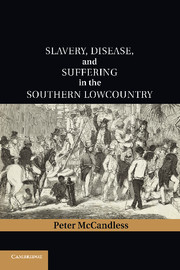Book contents
- Frontmatter
- Contents
- List of Figures
- List of Maps
- Preface
- Acknowledgments
- List of Abbreviations Used in Notes
- MAP 1 The Lowcountry, Charleston, and the Caribbean region
- MAP 2 The South Carolina lowcountry, showing Anglican parishes and slave proportion of population, c. 1760s
- MAP 3 Charleston Harbor, based on a British map, c. 1780
- MAP 4 The Revolutionary War in the South
- PART I TALK ABOUT SUFFERING
- 1 Rhetoric and Reality
- 2 From Paradise to Hospital
- 3 “A Scene of Diseases”
- 4 Wooden Horse
- 5 Revolutionary Fever
- 6 Strangers' Disease
- 7 “A Merciful Provision of the Creator”
- PART II COMBATING PESTILENCE
- Bibliography
- Index
- References
3 - “A Scene of Diseases”
Published online by Cambridge University Press: 03 May 2011
- Frontmatter
- Contents
- List of Figures
- List of Maps
- Preface
- Acknowledgments
- List of Abbreviations Used in Notes
- MAP 1 The Lowcountry, Charleston, and the Caribbean region
- MAP 2 The South Carolina lowcountry, showing Anglican parishes and slave proportion of population, c. 1760s
- MAP 3 Charleston Harbor, based on a British map, c. 1780
- MAP 4 The Revolutionary War in the South
- PART I TALK ABOUT SUFFERING
- 1 Rhetoric and Reality
- 2 From Paradise to Hospital
- 3 “A Scene of Diseases”
- 4 Wooden Horse
- 5 Revolutionary Fever
- 6 Strangers' Disease
- 7 “A Merciful Provision of the Creator”
- PART II COMBATING PESTILENCE
- Bibliography
- Index
- References
Summary
At Midnight when the Fever rag'd
By Physick Art still unasswag'd,
And tortur'd me with Pain:
When most it scorch'd my aching Head,
Like sulph'rous Fire, or liquid Lead,
And hiss'd through every Vein.
South Carolina Gazette, July 28, 1732I was ill with fever in Purrysburg about three months and afterwards in Georgia at Savannah … I had the bloody flux for six months. Also a great swelling befell me. My whole belly was swollen so that I might have burst.
Samuel Dyssli, 1737I am heartily tired of Carolina and dread the approach of summer which I am afraid will renew my intermittent complaint, from which I have never been thoroughly free since August last.
John Murray of Murraywhat, 1763“A COMPLICATION OF DISORDERS”
In 1711, Gideon Johnston, Anglican Commissary in Charleston, described his body as “a scene of diseases.” The phrase could have been a metaphor for the lowcountry, for it encapsulated the experience of much of the population. Another Anglican missionary aptly summed up the situation when he wrote that he had endured “a complication of disorders.” Many people suffered almost continually from one disease or another, sometimes several at once. It is not always possible to determine what people suffered or died from in particular cases, but we can identify the major culprits. The most visible suffering was that caused by deadly epidemics, mainly smallpox and yellow fever but also other epidemics from time to time. Such “malignant” epidemics were part of the public sphere: Official documents and newspapers (after 1731) often discussed them, at least once they could no longer be denied to exist. Harder to detect in public sources are the endemic disorders that claimed numerous victims every year.
- Type
- Chapter
- Information
- Publisher: Cambridge University PressPrint publication year: 2011

